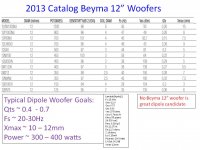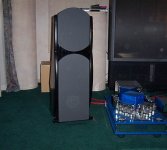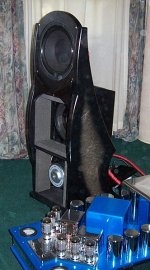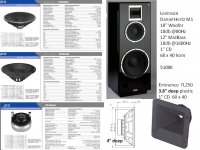A friend is contemplating the next project. Size is a factor so leaning towards 12" bass drivers in U-shaped OB.
Initial thoughts:
- Bass: 2 x 12" (Beyma 12BR70 8\Ohms in parallel)
- Mid-high: Beyma 8CX20 (or 8CX300Nd if funds permit), or
- Mid-high variant #2: FaitalPro 8HX150 (or 8HX200, ditto)
The crossing between the bass and mid/high section will be active.
Any opinions and/or suggestions to the above? A pair of 12BR70 looks (on paper) like it may work well in OB even though the Qts is a little below 0,40 but DSP (DEQ) should help there if needed.
Or it is safer to go with a single 15" even though that will increase the size and will deviate from the initial idea of narrow-ish baffle (Eminence Delta LFA 15, etc)?
Any experience with the above listed 8" coaxials?
All remarks/comments are welcome at this early stage of planning.
Thanks to all in advance.
Initial thoughts:
- Bass: 2 x 12" (Beyma 12BR70 8\Ohms in parallel)
- Mid-high: Beyma 8CX20 (or 8CX300Nd if funds permit), or
- Mid-high variant #2: FaitalPro 8HX150 (or 8HX200, ditto)
The crossing between the bass and mid/high section will be active.
Any opinions and/or suggestions to the above? A pair of 12BR70 looks (on paper) like it may work well in OB even though the Qts is a little below 0,40 but DSP (DEQ) should help there if needed.
Or it is safer to go with a single 15" even though that will increase the size and will deviate from the initial idea of narrow-ish baffle (Eminence Delta LFA 15, etc)?
Any experience with the above listed 8" coaxials?
All remarks/comments are welcome at this early stage of planning.
Thanks to all in advance.
Hi,
As you all might know I'm not an expert in this type of speaker (OB). 😉
If you want to go with Beyma because of various conditions like logistics, price, and (all) including parameters, design and size, try 2 or 3 references from Beyma to choose from in a list:
Beyma CM10
Beyma 10BR60V2
Beyma 15KX coax
Beyma 15LX60V2
Beyma SM112/N
Discontinued Beyma 112Nd/W
Also driver car reference Beyma SCW12 (yellow colour).
As you all might know I'm not an expert in this type of speaker (OB). 😉
If you want to go with Beyma because of various conditions like logistics, price, and (all) including parameters, design and size, try 2 or 3 references from Beyma to choose from in a list:
Beyma CM10
Beyma 10BR60V2
Beyma 15KX coax
Beyma 15LX60V2
Beyma SM112/N
Discontinued Beyma 112Nd/W
Also driver car reference Beyma SCW12 (yellow colour).
The current Beyma catalog does not have a 'great' 12" dipole woofer candidate. As discussed, Beyma's Pro 12" woofers typically have modest Xmax plus a high'ish Fs, making them "marginal" dipole woofers which require extensive equalization.
The Peerless subwoofers are often used because of their fair pricing and large Xmax, but they have a low Qts and hence require extensive equalization.
There are "dipole designed woofers" that are robust with great sound. There are "small magnet cheap woofers" that have good dipole T/S parameters but modest performance. It is easier to find robust 15" woofers with good dipole T/S specs, but a cardboard mock-up of the 17" - 18" wide, 33" high H-frame cabinet is a good idea.
JohnK's Music and Design website has great information on dipole technology. Your friend may move away from a coaxial mid-tweet to a separate tweeter driver 4-way. You and your friend might consider cloning either JohnK's or Linkwitz latest 4-way dipoles. It would be more educational and possibly better sounding to build your own if you have a large budget.
The Peerless subwoofers are often used because of their fair pricing and large Xmax, but they have a low Qts and hence require extensive equalization.
There are "dipole designed woofers" that are robust with great sound. There are "small magnet cheap woofers" that have good dipole T/S parameters but modest performance. It is easier to find robust 15" woofers with good dipole T/S specs, but a cardboard mock-up of the 17" - 18" wide, 33" high H-frame cabinet is a good idea.
JohnK's Music and Design website has great information on dipole technology. Your friend may move away from a coaxial mid-tweet to a separate tweeter driver 4-way. You and your friend might consider cloning either JohnK's or Linkwitz latest 4-way dipoles. It would be more educational and possibly better sounding to build your own if you have a large budget.
Attachments
Want to follow your Dream?
GR Research offered a dipole speaker with two 12" servo dipole woofers plus a P-Audio 12" coaxial midbass with the rear of the compression driver cap machined off for dipole radiation. There is a long user discussion forum on this (retired) design. A dipole coaxial midbass is not my dream.... after reading the forum you may decide it is still your dream.
================
GR Super-V
"Each speaker uses a modified coaxial driver from P-Audio. It is their top level driver. The rear back cup on the tweeter is milled out to make it completely open baffle as well. This relaxes the upper ranges and allows them to give the listener the feel of instruments and performers really being there in the room rather than having the sound played back from a box. "
The Super-V has 97db sensitivity and is an easy 8 ohm load. So they can be driven easily with even single digit amps. And your amp only has to drive the upper coaxial driver. The two 12" servo controlled subs in the bottom of each speaker is powered by their own A370PEQ amplifier. "
Super-V
GR Research offered a dipole speaker with two 12" servo dipole woofers plus a P-Audio 12" coaxial midbass with the rear of the compression driver cap machined off for dipole radiation. There is a long user discussion forum on this (retired) design. A dipole coaxial midbass is not my dream.... after reading the forum you may decide it is still your dream.
================
GR Super-V
"Each speaker uses a modified coaxial driver from P-Audio. It is their top level driver. The rear back cup on the tweeter is milled out to make it completely open baffle as well. This relaxes the upper ranges and allows them to give the listener the feel of instruments and performers really being there in the room rather than having the sound played back from a box. "
The Super-V has 97db sensitivity and is an easy 8 ohm load. So they can be driven easily with even single digit amps. And your amp only has to drive the upper coaxial driver. The two 12" servo controlled subs in the bottom of each speaker is powered by their own A370PEQ amplifier. "
Super-V
Attachments
Thanks Inductor, LineSource.
It looks like 12BR70's will go in a box after all.... He is getting them (has too good a deal to miss it).
So with two of them in a box (perhaps one front/one back, in bipole), will the 8" coaxial (open back) be a good match?
Or in this case it's safer (and simpler) to go 2-way with a compression driver/horn at, say, 1300-1500 hz ?
It looks like 12BR70's will go in a box after all.... He is getting them (has too good a deal to miss it).
So with two of them in a box (perhaps one front/one back, in bipole), will the 8" coaxial (open back) be a good match?
Or in this case it's safer (and simpler) to go 2-way with a compression driver/horn at, say, 1300-1500 hz ?
It looks like 12BR70's will go in a box after all....
Or in this case it's safer (and simpler) to go 2-way with a compression driver/horn at, say, 1300-1500 hz ?
"Go BIG or Go Home!" is a common idiom.
The Russian President has a pair of Daniel Hertz M1 speakers. 18" + 12" + 60x40 horn/waveguide
Your friend might have similar dreams.
Controlled Directivity Speakers have a thoughtful, smooth, polar transistion function between 360 degree bass, to 180 degree baffle width forward polar radiation, to a gradual tighter polar response as the tweeter starts to beam from physical width physics.
Study the polar response of the 12BR70. Determine at what frequency the polars are 3db down, 6db down, 12db down.
The Daniel Hertz M1 selected a crossover frequency(1600) where their 12" midbass started to have a 6db down at 60 degree polar response. Physically butting a 60 degree horn on top of the 12" with a 3rd order or 4th order Xover slope creates the critical smooth polar transistion. A lower Xover frequency would allow a smooth transistion to a 90 degree horn/waveguide, but will have a different cone-to-horn sound. Cone drivers pump more energy into the room than a horn/waveguide, and this creates a different audio illusion.
You also want time-alignment match between the 12" and compression driver, and this is why the M1 uses a short 3.9" 60x40 horn to allow the coaxial driver voice coil to physically align with the 12" voice coil.(you really want to run a square wave to each driver and watch the time delay on a O'scope ... or at least ear)
I use a Lambda TD10M with a LR4 Xover at 1200Hz to a 90 x 40 waveguide to obtain this smooth polar transistion just above the human vocal range.
Attachments
Looks like Levinson has turned the horn 90¤ for some reason... It hardly has same horizontal directivity as 8" mid. But I might be wrong.
Dimitry Medvedev is now the Prime Minister of Russia. The picture is perhaps from the Presidential residence in Kreml, but I think that equipment is his own.. In some pics M is serving a cake to Mr. P http://www.google.fi/search?q=danie...tPMOS4ASDtIGoCQ&ved=0CC8QsAQ&biw=1288&bih=831
Dimitry Medvedev is now the Prime Minister of Russia. The picture is perhaps from the Presidential residence in Kreml, but I think that equipment is his own.. In some pics M is serving a cake to Mr. P http://www.google.fi/search?q=danie...tPMOS4ASDtIGoCQ&ved=0CC8QsAQ&biw=1288&bih=831
An externally hosted image should be here but it was not working when we last tested it.
Last edited:
- Status
- Not open for further replies.
- Home
- Loudspeakers
- Multi-Way
- OB 3-way with Beyma




